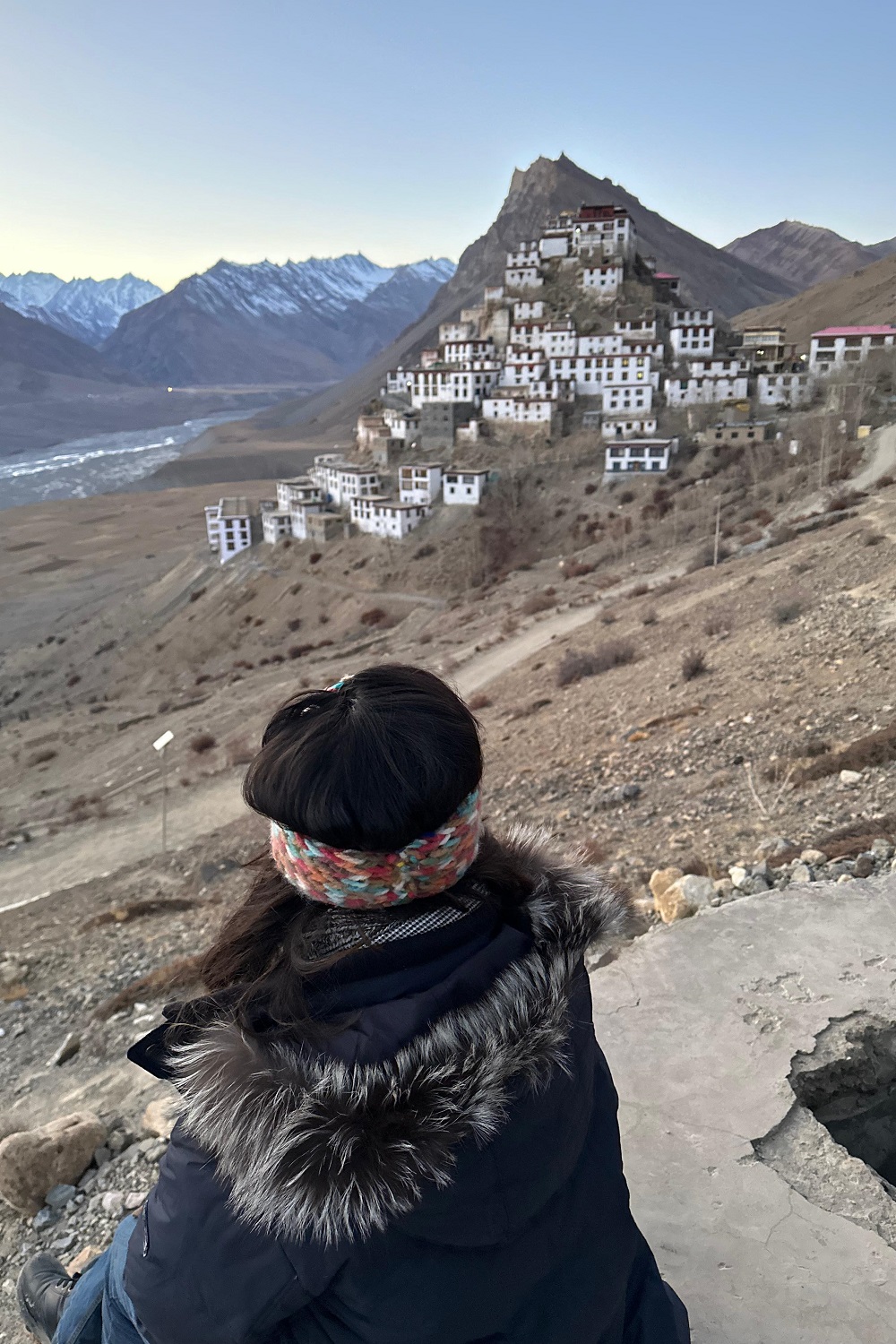Disclaimer: This post may contain affiliate links, meaning I will earn a small commission if you purchase through my link at no extra cost to you. For more information, check here.
As a corporate professional in Ahmedabad, my days usually revolve around deadlines, meetings, and an endless stream of emails. But this past winter, I decided to break away from the monotony and embark on a soul-refreshing journey to the breathtaking Spiti Valley.
It was a much-needed escape into the wild, frozen beauty of the Himalayas, and I couldn’t have asked for a more perfect destination.
The Beginning: Delhi to Shimla-Saharan-Kinnaur Route
I started my trip from Delhi, packed with all the warm clothing I could manage, ready for a frosty adventure.
Taking the Shimla-Saharan route was an absolute treat. This route is known for its winding roads, lined with pine trees and offering stunning panoramic views of snow-capped mountains.
Passing through towns and villages, I found the journey itself to be part of the charm.
Reaching Kinnaur was my first real taste of what Spiti Valley had to offer. Known for its dramatic landscape of towering mountains and deep gorges, Kinnaur was both intimidating and beautiful.
I felt dwarfed by the sheer scale of the natural surroundings. The region is famous for apple orchards, and I couldn’t resist tasting the crisp, juicy Kinnauri apples!
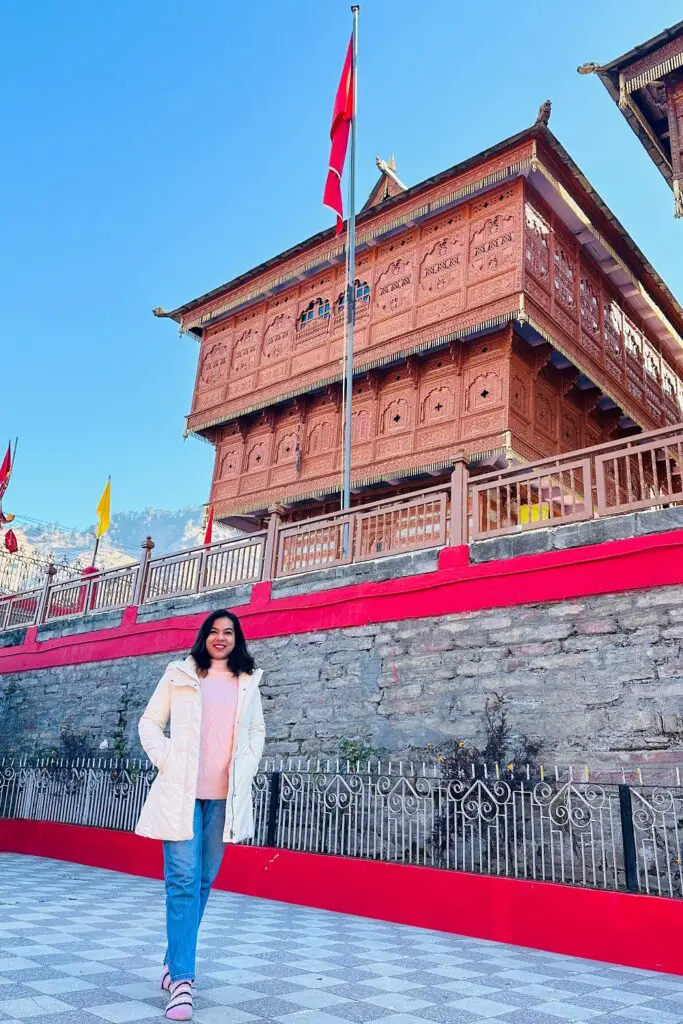
Chitkul: The Last Inhabited Village
After a brief stop in Kinnaur, I made my way to Chitkul, the last inhabited village near the Indo-Tibetan border.
The drive from Kinnaur to Chitkul was filled with the most gorgeous scenery—glistening rivers, dense pine forests, and icy peaks in the background.
I stayed in a cozy camp in Chitkul, where I felt like I was truly away from civilization. The night was freezing, but the thrill of staying in such a remote place, surrounded by pristine snow, made it all worth it.
It was winter, and the Baspa River had mostly frozen over, creating a surreal landscape of snow and ice.
My friends and I decided to camp by its banks for the night, drawn by the untouched beauty and the idea of spending an evening under the stars.
We pitched our tents close to the river, where the sound of the trickling water mixed with the stillness of the winter air.
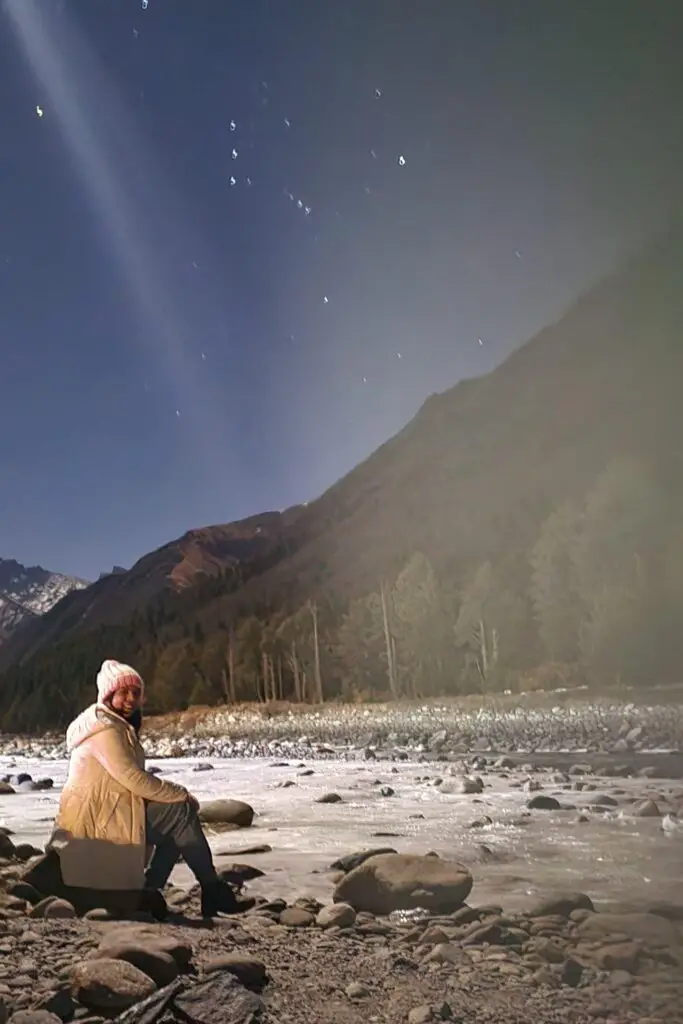
The temperature dropped as the sun dipped behind the mountains, but the excitement of camping in such a remote location kept us warm.
I had met a few fellow travelers during the trip, and we quickly became friends, bonding over our shared love for adventure and the incredible journey we were on.
That night, we built a small bonfire to keep ourselves warm, sat around it, and gazed up at the night sky. Chitkul, far removed from city lights and pollution, offered a view of the Milky Way that I had only ever seen in photographs.
The sky was a blanket of twinkling stars, and for the first time in ages, I felt truly connected to the vastness of the universe.
We spent hours stargazing, identifying constellations, and exchanging stories, our breath forming little clouds in the freezing air.
Waking up to the sight of the rising sun lighting up the snow-clad mountains was an experience I’ll never forget. Chitkul, despite its isolation, felt like a serene paradise untouched by the modern world.
The next morning, after breaking camp, we set off to explore more of the region. One of the most awe-inspiring moments of the trip came when we visited the Khab Bridge, where the Spiti and Sutlej Rivers meet.
The sight of the two rivers converging was breathtaking—one flowing in from the cold, barren landscape of Spiti, and the other rushing down from the Sutlej valley.
Tabo: The Ancient Monastery, Frozen Waterfalls and the Warm Welcome of Pahaadi Dogs
After leaving Chitkul behind, we continued our journey deeper into Spiti, arriving at the ancient village of Tabo.
Known for its rich history and spiritual significance, Tabo is home to the renowned Tabo Monastery, often called the “Ajanta of the Himalayas” due to its exquisite murals and ancient caves carved into the mountainside.
But beyond its cultural treasures, Tabo also surprised me with some unexpected natural wonders and the heartwarming company of some furry locals.
During one of our exploration days, we decided to venture into the Lingti Valley, a secluded and relatively lesser-known spot near Tabo.
The valley, surrounded by jagged peaks and rocky terrain, felt like another planet. It was winter, and we were lucky enough to witness a stunning frozen waterfall cascading down the cliffs.
The water, mid-fall, had solidified into intricate formations of ice, shimmering in the soft sunlight. It looked like a sculpture carved by nature itself, with icicles hanging delicately from the rock face. The whole scene was surreal, almost like stepping into a winter fairy tale.
We stood in silence, mesmerized by the stillness of the frozen fall and the stark beauty of the valley.
But not everything in Tabo was icy and cold—there was plenty of warmth to be found in the company of the pahaadi dogs that roamed the village. These mountain dogs, with their thick fur and soulful eyes, quickly became our little companions as we explored the area. They seemed to belong to no one and everyone at the same time, wagging their tails and trotting alongside travelers with an air of friendly curiosity.
One in particular, a fluffy white dog with a mischievous streak, followed us everywhere we went, even nudging us for treats every now and then. I couldn’t resist giving them a few biscuits, and soon, I found myself surrounded by an entourage of cute, fluffy tails wagging in excitement. Their playful nature and resilience in the cold made them the perfect little mascots of our time in Tabo.
The warmth of these furry friends added a touch of joy and comfort to the cold, rugged landscape. Whether they were lounging in the sun or accompanying us on our walks, the pahaadi dogs brought smiles to our faces and made us feel at home in the heart of the Spiti wilderness.
Tabo, with its frozen waterfalls, spiritual energy, and friendly locals—both human and canine—was a beautiful reminder that even in the coldest places, warmth can be found in the most unexpected ways.
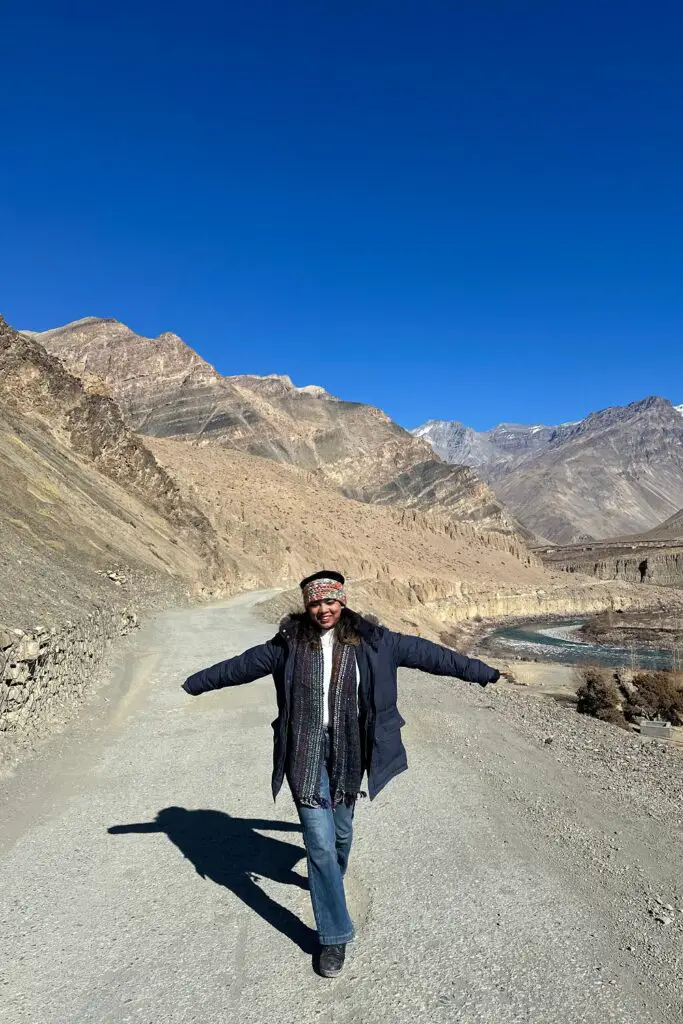
Kaza: The Heart of Spiti
My next stop was Kaza, the main town of Spiti Valley and my base for exploring the surrounding villages. Even in the heart of winter, Kaza had a quiet charm, with its whitewashed houses and snow-covered streets. The Spiti River, partially frozen, meandered through the town, reflecting the grandeur of the surrounding mountains.
Kaza is a perfect place to explore the rich culture and history of Spiti. The locals, despite the harsh conditions, were warm and welcoming, and I had the opportunity to indulge in traditional Spitian food. The momos and thukpa, hot and spicy, were just what I needed to fight the cold!
Hikkim: World’s Highest Post Office
Just a short drive from Langza is Hikkim, home to the world’s highest post office. At an altitude of 14,567 feet, this tiny post office connects the remote villages of Spiti to the rest of the world. I couldn’t resist sending a postcard to my family from here. There’s something so special about sending a letter from one of the most isolated places on Earth, I sent one to myself, one to my best friend and one to my parents.
Komic: The Highest Village in the World
After Hikkim, I made my way to Komic, the highest village in the world connected by a motorable road. At 15,500 feet, Komic is as remote as it gets. The village was blanketed in snow, and the silence here was almost deafening.
Visiting the Komic Monastery, I was struck by how the monks here live in such extreme conditions, completely cut off from the rest of the world for months during winter.
The sheer altitude and remoteness of Komic made me realize the resilience of the people who live in Spiti Valley. Despite the harsh environment, they have maintained their way of life, steeped in spirituality and connection to nature.
Langza: Fossil Village with a Giant Buddha
The journey to Langza, one of the most iconic villages in Spiti, felt like stepping into a postcard. Perched at an altitude of 4,400 meters, the village is surrounded by the towering Himalayan ranges, and the sight of the giant Buddha statue overlooking the valley was both humbling and awe-inspiring.
Known as the “Fossil Village” for the marine fossils found in its soil, Langza offers a rare glimpse into the ancient past of this high-altitude desert.
But it wasn’t just the landscape that made Langza special—it was the experiences and surprises we encountered along the way.
Crossing the Chicham Bridge: The World’s Highest Suspension Bridge
On our way to Langza, we took a detour to visit the famous Chicham Bridge, the highest suspension bridge in Asia.
Suspended over a deep gorge, the bridge connects two villages and is an engineering marvel, but more than that, the views from the bridge were breathtaking. Standing on the bridge, looking down at the dizzying depths of the canyon, I felt a rush of adrenaline.
The wind howled through the gorge, and below, I could see tiny specks of blue, which were frozen streams snaking through the barren landscape.
Crossing the Chicham Bridge was an experience in itself, adding a sense of adventure to our otherwise serene trip.
Warm Homestays: A Cozy Escape from the Cold
By the time we reached Langza, the cold had settled in, and after spending so many nights camping, the idea of staying in a warm, traditional Spiti homestay felt like a blessing.
The homestays in Langza are known for their hospitality, and we were welcomed into a cozy mud house, warmed by a traditional tandoor (wood-fired stove) in the center of the room. The hosts, a warm Spitian family, made us feel right at home, serving us delicious, simple meals of thukpa and butter tea.
The warmth of the homestay, both in temperature and in spirit, was the perfect counter to the biting cold outside. That night, wrapped in thick blankets and listening to the wind howling through the valley, I drifted off to sleep feeling grateful for the kindness of strangers and the beauty of shared experiences.
The Mysterious Natural Mummy of Gue
During our stay in Langza, we took a day trip to the nearby village of Gue to witness something truly extraordinary—the natural mummy of a Tibetan monk.
Unlike the mummies preserved in museums, this mummy is housed in a small temple in the village and has been naturally preserved for over 500 years, sitting in a meditative posture.
Seeing it up close was a surreal experience, the monk’s serene face and posture a testament to his deep spirituality. The locals believe that the mummy has been protected by divine powers, and the sense of mysticism surrounding it was palpable.
One of the more amusing and unexpected experiences we had while in Gue was that our phones suddenly picked up the China mobile network.
Given the proximity of the region to the Tibetan border, it wasn’t entirely surprising, but it did serve as a reminder of how remote we were.
It was a funny moment shared among fellow travelers, who were equally surprised by the network signal. Even in the remote and rugged Spiti Valley, the world felt connected in the most unexpected ways.
Nako Lake: A Frozen Gem in the Mountains
Another highlight of our trip was visiting Nako Lake, a small yet stunning body of water that, in winter, freezes over entirely.
Surrounded by barren hills and traditional stone houses, the lake looked like a mirror reflecting the cold, crisp sky.
While the lake itself was frozen solid, giving us the unique opportunity to walk on its icy surface, the surrounding area had a quiet, meditative quality that made it feel like time had stopped. We sat by the lake for a while, soaking in the peace and solitude, before heading back to Langza.

Nako Lake’s stillness contrasted beautifully with the rugged terrain we had been navigating throughout our trip, offering a moment of calm in the midst of our adventure.
Langza, with its sweeping landscapes, warm homestays, mystical discoveries, and even amusing reminders of modern connectivity, was a place of contrasts.
From the adventure of crossing Chicham Bridge to the peaceful serenity of Nako Lake, every moment in Langza was filled with wonder.
The natural beauty of the region, combined with the warmth of its people and the deep sense of spirituality, made it a place I’ll never forget.
My time there was not just about ticking off spots from a travel itinerary, but about embracing the slow, quiet rhythm of life in the high Himalayas—something that left an indelible mark on my soul.
Key Monastery: Monastery on a Cliff
Among the many breathtaking experiences in Spiti, my visit to the Key Monastery stands out as one of the most spiritually enriching.
Located about 12 kilometers from Kaza, Key Monastery (also spelled Ki Monastery) is perched dramatically on a hilltop at an altitude of 4,166 meters, overlooking the vast Spiti Valley.
As one of the largest and oldest monasteries in the region, it’s not just a center of Tibetan Buddhism, but also a symbol of Spiti’s rich cultural heritage.
The Journey to Key Monastery
The drive up to Key Monastery was as spectacular as the destination itself. Winding roads snaked through rugged mountain terrain, with the vast Spiti River cutting through the valley below.
The landscape was barren, yet stunning, with brown, rocky mountains framing the endless blue sky.
As we approached, the monastery came into view, rising out of the rocky hillside like something out of a dream. Its whitewashed walls and tiered structure seemed to defy gravity, clinging to the steep slopes, a true architectural marvel.

Entering Key Monastery: A Step Back in Time
Walking through the gates of Key Monastery felt like stepping back in time. Founded in the 11th century, the monastery has withstood invasions and natural calamities, yet it remains a hub of spirituality and learning.
The moment I entered, I was greeted by the sight of fluttering prayer flags, the sound of monks chanting, and the smell of burning incense. The atmosphere was both peaceful and profound, as though the centuries of devotion had seeped into the very stones of the monastery.
I was lucky to arrive during one of the daily prayer sessions, and the soft hum of Tibetan chants resonated throughout the halls. The young monks, dressed in their deep red robes, sat in rows, their faces calm and focused as they recited ancient scriptures.
There was a powerful sense of devotion in the air, and I couldn’t help but feel a deep sense of peace wash over me as I stood quietly, absorbing the energy of the place.
But what took my breath away, quite literally, was the view from the top of the monastery. Climbing up to the rooftop, I was rewarded with a panoramic view of the entire Spiti Valley. The vast expanse of the valley, with the Spiti River snaking through its center and the jagged mountains in the distance, was awe-inspiring
Standing there, looking out over the endless horizon, I felt incredibly small, yet deeply connected to the natural beauty around me. The sense of peace and stillness was overwhelming.
As I left the monastery, I felt a deep sense of contentment and inner peace, as though I had touched something far greater than myself.
Dhankar Monastery
From Tabo, I continued to Dhankar, a small village perched on the cliffs overlooking the confluence of the Spiti and Pin rivers.
The highlight here was the Dhankar Monastery, precariously situated on the edge of a cliff. The view from the monastery was absolutely breathtaking, with the Spiti River snaking through the valley far below and snow-covered mountains stretching as far as the eye could see.
Dhankar also has a hidden gem—a lake located a short trek away from the village. I braved the cold and made the trek to Dhankar Lake. The frozen lake, surrounded by snow, felt like something straight out of a dream. It was a peaceful spot, with the only sound being the wind whistling through the mountains.
Kinnaur Kailash
As my incredible journey through the Spiti Valley came to a close, I knew I wanted to end it on a high note—quite literally.
For my final night, I decided to stay near the majestic Kinner Kailash in Kalpa, a small village in the Kinnaur district. After days of exploring the rugged landscapes of Spiti, Kalpa provided the perfect setting for a peaceful and reflective finale to the trip.
As the evening approached, I settled into a cozy homestay with a panoramic view of the Himalayas.
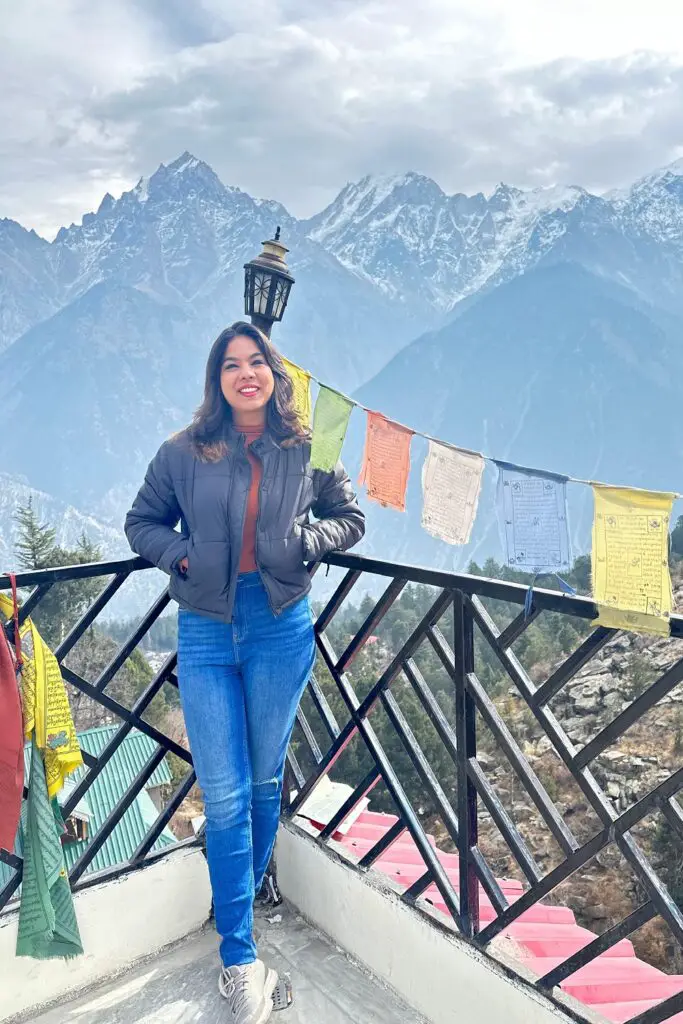
Upon waking up, the sight of Kinner Kailash towering in the distance left me speechless. The mountain, considered sacred in Hindu mythology, stood tall and proud, its peaks draped in snow, bathed in the soft golden light of the setting sun.
The locals believe that the mountain is the winter abode of Lord Shiva, and it’s easy to see why. The sheer presence of Kinner Kailash radiates a sense of calm and reverence.
Why You Should Visit Spiti-A Journey Like No Other
My journey through Spiti Valley was nothing short of transformative. From the ancient monasteries of Tabo and Dhankar to the remote villages of Langza, Hikkim, Kaza and Komic, every stop was a new adventure.
Traveling from 28 degrees to -18 degrees is going to be the main highlight of Spiti. Winter in Spiti Valley is not for the faint-hearted, but for those willing to brave the cold, it offers an experience unlike any other. It’s a land where time slows down, where the silence speaks, and where the majesty of nature reminds you just how small we are in the grand scheme of the universe.
If you’re looking for an adventure that will challenge you, inspire you, and leave you with memories to last a lifetime, Spiti Valley in winter should be at the top of your list.
Pallavi, signing off from Ahmedabad, where I’m already dreaming about my next mountain escape.

